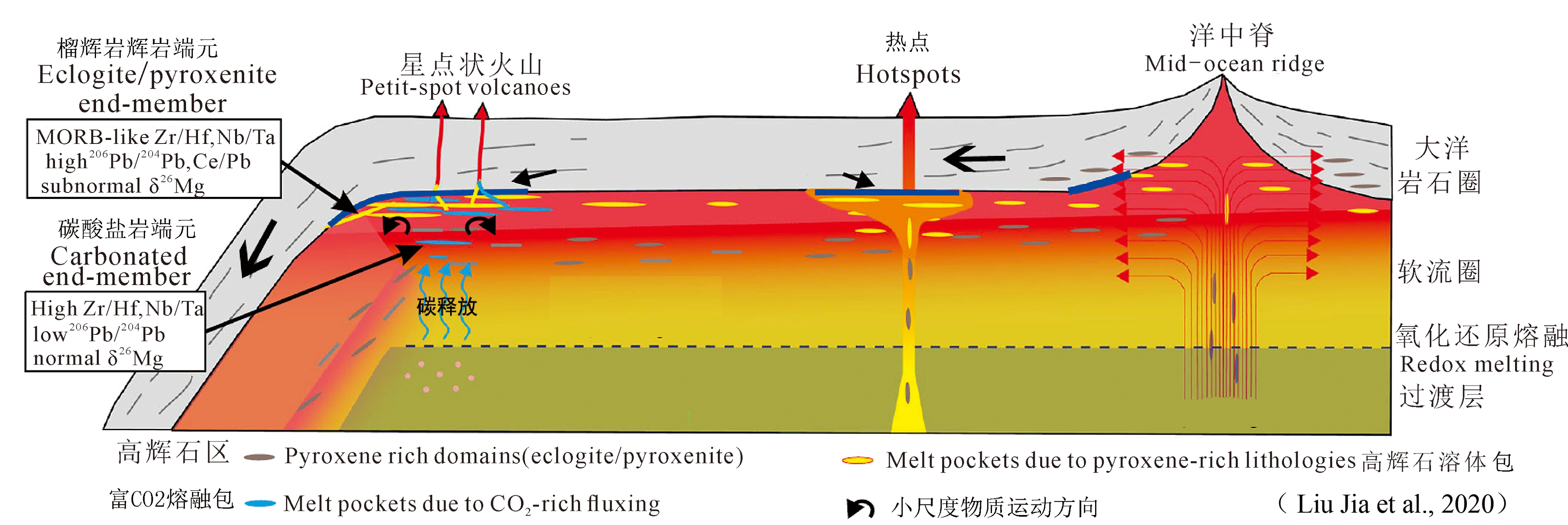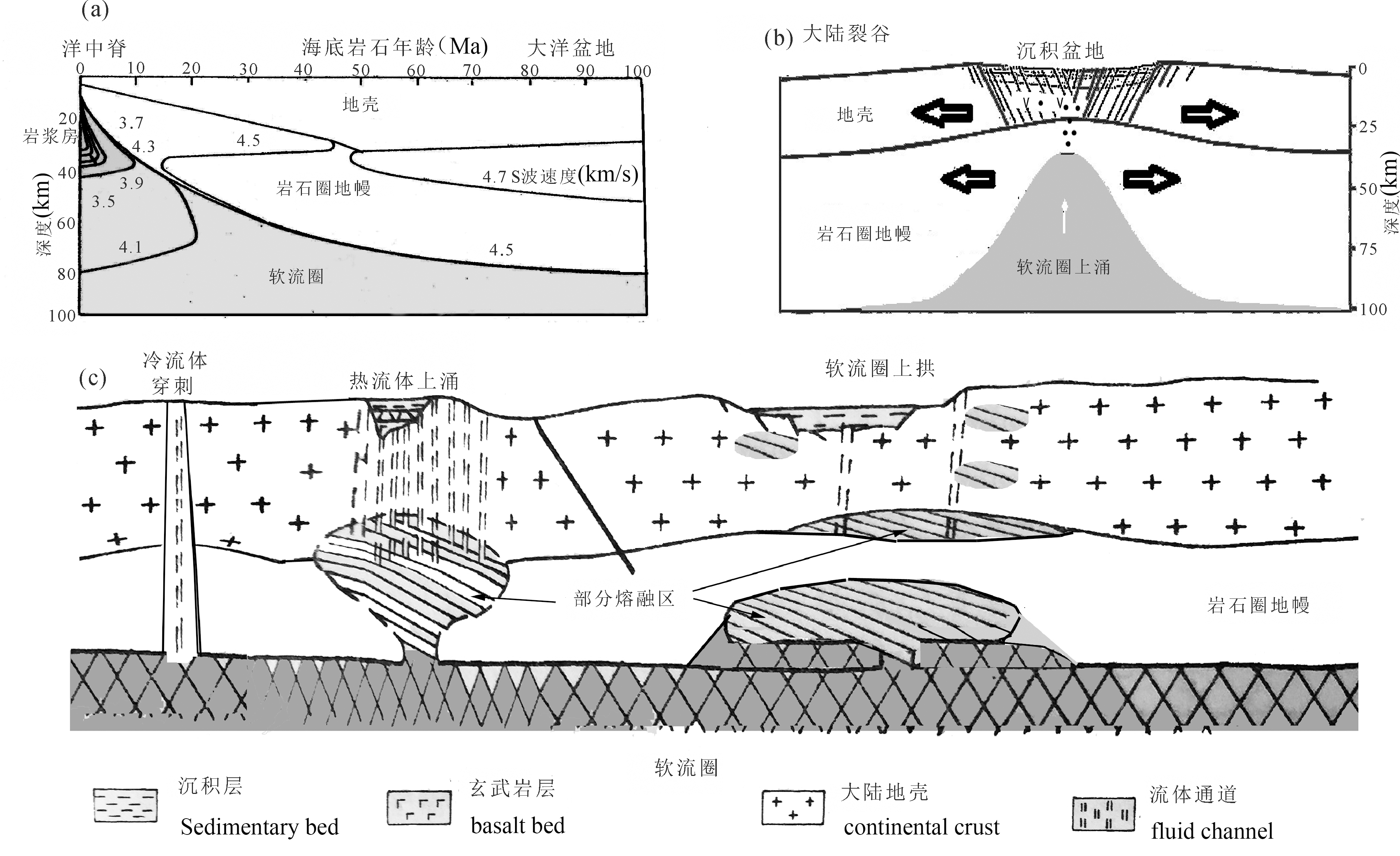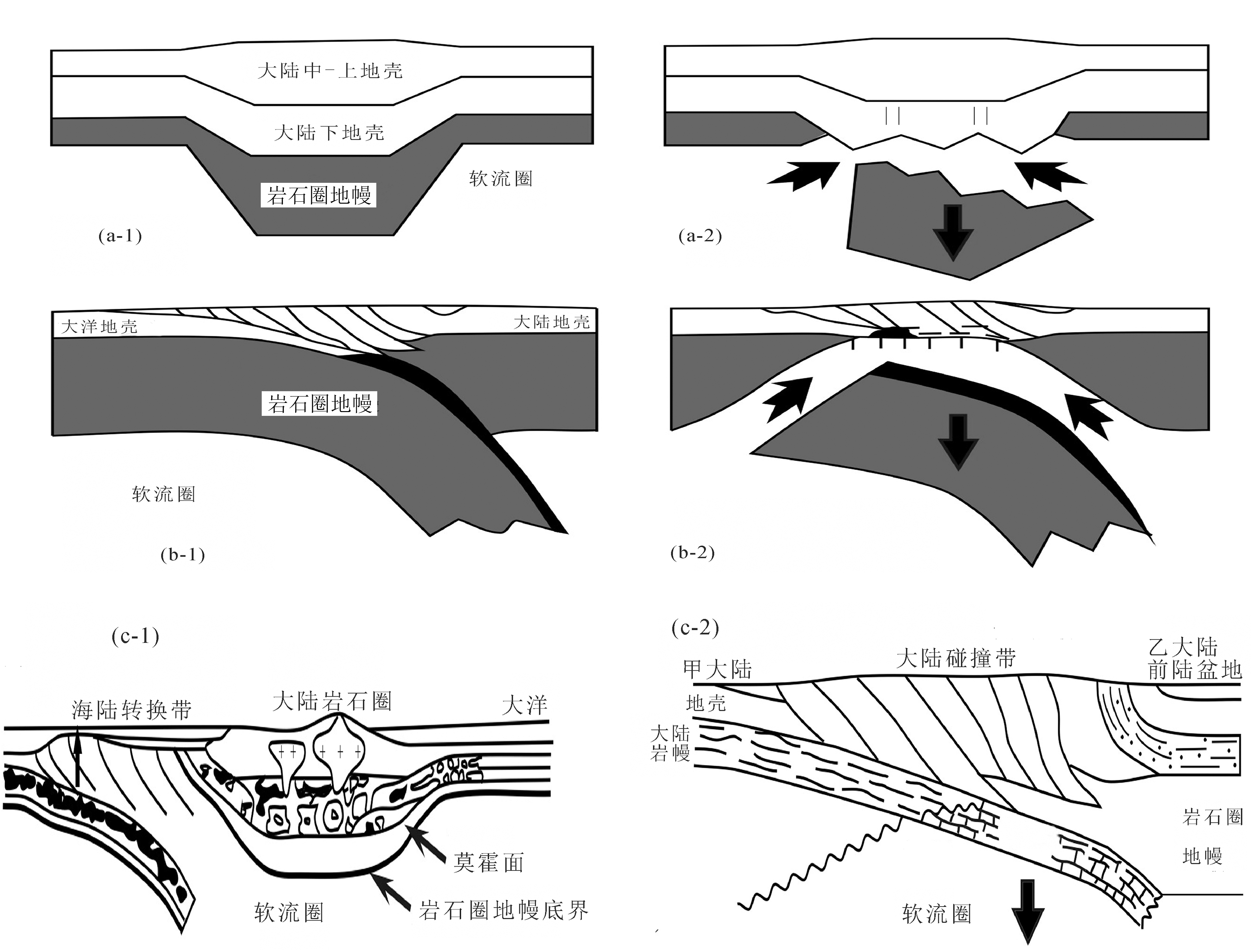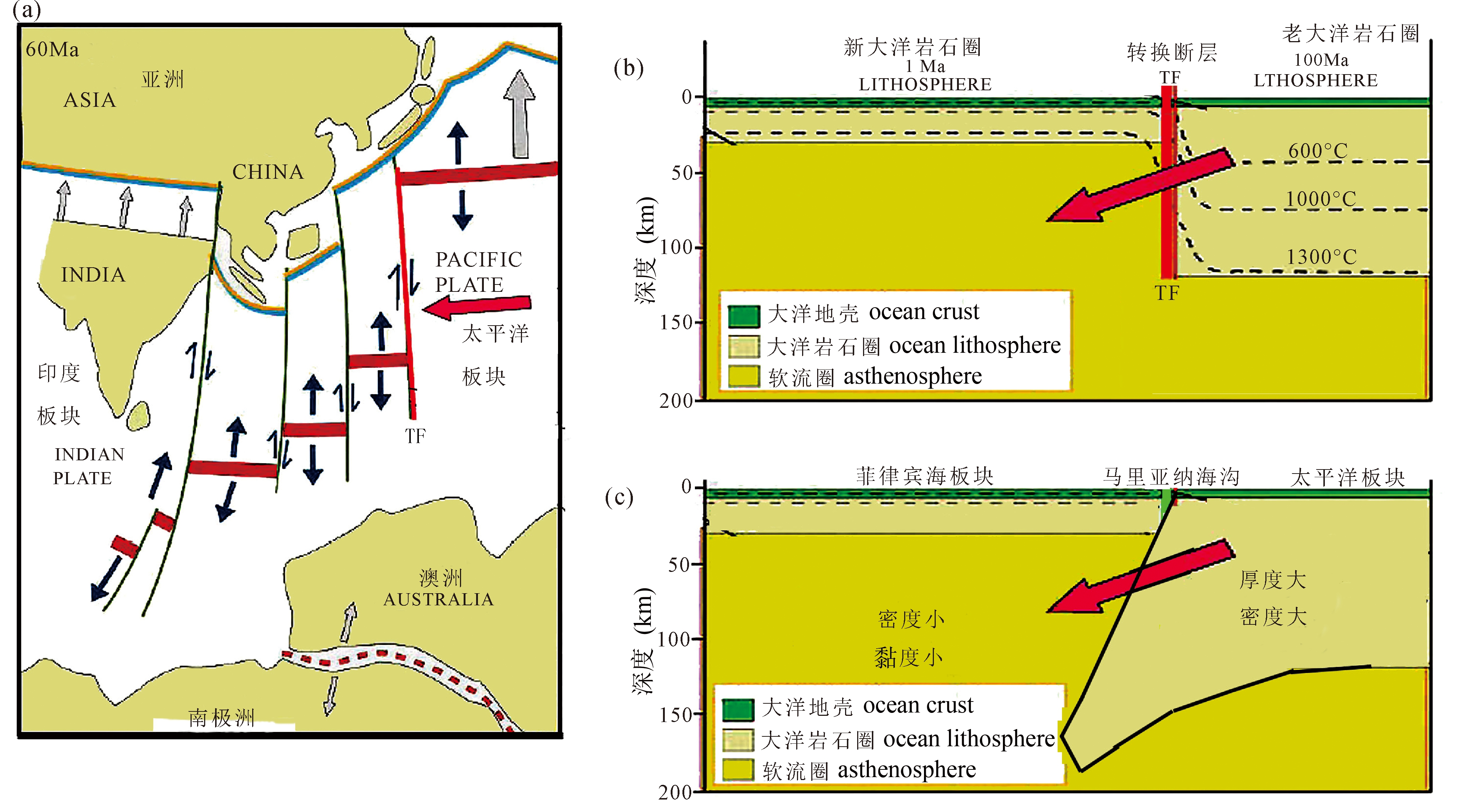这是讨论地球浅地幔系统的第三篇文章。在第一篇“认知地球物质运动的大陆动力学方法”(杨文采等,2020)一文中,为克服板块构造学的存在问题, 我们讨论了固体地球三维成像研究提供的基础,通过大陆动力学的研究可以建立板块构造学的升级版。从最近几年的地幔地球物理三维成像成果(Anderson,1989; Pakiser and Mooney, 1989; Ritsema, 2000; Unsworth et al., 2005; Shi et al., 2008; Cloetingh and Negendank, 2009 )可见,对于地球表面难以观察的软流圈和地下深部,对比三维的地震波速和电阻率扰动图像,可以获得关于上地幔物质运动的信息,认知已经发生在地壳—上地幔的物质运动特征。在第二篇“浅地幔系统的组成和属性相态”(杨文采,2020)一文中,我们讨论了地球系统应该划分为地球表面、浅地幔、地幔对流和地核四个子系统。浅地幔子系统由四个由不同质的单元相互作用组成,它们是大洋岩石圈、大陆岩石圈、洋陆转换带岩石圈和软流圈。系统的作用反映了大洋岩石圈与大陆岩石圈的博弈,洋陆转换带是洋底扩张与大陆增生之间博弈的主要战场。软流圈是地幔对流的顶层,也是系统的能量库和主要动力来源。在本文中我们将继续讨论浅地幔系统物质的三种主要形式:水平运动、向上涌动和向下沉动。从目前的成像结果可以看到,对于地球表面难以观察的岩石圈深部和软流圈,对比三维的地震波速和电阻率扰动等构造图像,可获得中生代以来物质运动的信息,认知已经发生在地壳—上地幔的物质运动特征(杨文采,1986,1989,1997; 杨文采等,2014,2017; Yang Wencai, 2003, 2014; Yang Wencai et al., 2006)。

图1 中国及邻区软流圈地震P波速度扰动三维成像平面图(据 Li Chang et al., 2006), 平面图对应深度:
(a) 200 km, (b) 300 km, (c) 400 km,(d) 600 km
Fig. 1 The P-wave velocity disturbance images around China(from Li Chang et al., 2006):(a) at depth of 200 km; (b) 300 km; (c) 400 km; (d) 600 km
蓝色为高波速区,以F开头编号;红色为低波速区,以S开头编号
Blue shows high-velocity blocks with numbering from letter “F”; yellow shows low-velocity blocks with numbering from letter “S”
在板块构造学中假设,岩石圈板块是刚性的整体,浅地幔系统的物质运动用板块运动来代替就可以了。由于软流圈的黏度不够高,物质运动的形式主要是大尺度的蠕动,板块构造学的假设不再适合了。此外,大陆和大洋在年龄和结构上差别很大,对物质运动有很大影响,而板块构造学对此也没有仔细考虑。物理学用黏度来表示物质的宏观运动特性。根据地球物理的观测推导,现今下地壳的黏度比上地壳和下方的岩石圈地幔都低。但是,下地壳大规模的物质运动只能发生在局部地区(杨文采等,2018,2019a,b,c;杨文采,2019)。岩石圈板块浮在软流圈之上,可以作切线方向运动;也可以在软流圈黏性物质运动带动下作上下运动。关于岩石圈物质运动的理论必须建立在浅地幔系统的所有物质运动的基础上,结合地质测年和岩石同位素测量的数据,从软流圈物质大尺度蠕动图像中揭示上地幔构造,分析它们形成的动力学作用的根源,尽可能避免想象。这就是在本文关于浅地幔系统的讨论中我们的主导思想。
1 浅地幔系统物质的水平运动及其效应
浅地幔系统在不受外来力量冲击的情况下,造成浅地幔系统物质运动的能量主要包括来自软流圈及其下方的热能和动能,以及由地球引力产生的势能。造成浅地幔系统物质向下运动的能量由地球引力产生的势能引起,其他方向的运动主要由热能和动能引起。除了动力来源之外,浅地幔系统物质运动的方向还取决于岩石圈和软流圈的构造,因为高黏度介质阻挡物质运动,而低黏度介质加速物质运动。

图2 浅地幔系统的物质运动的不同方式示意图(据 James, 1989;Jolivet and Hataf, 2001;Rogers, 2004等修改):(a) 差异水平运动,产生岩石圈伸展; (b) 差异水平运动,产生沉积盆地; (c) 差异水平运动,产生地壳推覆; (d) 软流圈垂直上涌,产生岩石圈伸展; (e) 软流圈斜侧上涌,产生岩石圈推覆; (f) 软流圈垂直下沉,产生岩石圈推覆
Fig. 2 The mass movement modes in the shallow mantle system(modified from James, 1989;Jolivet and Hataf, 2001;Rogers, 2004 et al.):(a) discrepancy in horizontal movement and causing extension; (b) discrepancy in horizontal movement and emerging basins; (c) discrepancy in horizontal movement and emerging nappes; (d) discrepancy in vertical upwelling and causing extension; (e) discrepancy in dipping upwelling and emerging nappes; (f) discrepancy in vertical depression emerging nappes
全球板块构造是了解岩石圈构造复杂性的好模型,可惜没有揭示软流圈构造的复杂性。中国及邻区软流圈地震P波速度扰动三维成像(图1)揭示了软流圈构造的复杂性(Li Chang et al.,2006)。由图1a可见,岩石圈和软流圈的界面是起伏不平的,软流圈上部蓝色为高波速区,反映了位于克拉通下方的大陆的根,如F2是西伯利亚克拉通,F5是华北鄂尔多斯克拉通,F6是上扬子克拉通。红色的低波速区主要反映中—新生代大陆构造活动带,如S1~S4反映西太平洋板块俯冲的前方拉伸带。在软流圈下部(图1c,深度300~410 km),波速扰动图像发生了根本的变化,与岩石圈板块构造的相关性很差,与中—新生代大洋板块俯冲作用和其他深层作用的相关性增强了。在软流圈下方(如图1d,深度600 km),波速扰动图像的格局几乎完全改变,红色的低波速区(S5~S7)主要反映大陆,蓝色的高波速区(F4~F8)主要反映含大量大洋俯冲板块的洋陆转换带,但是也有可能反映地幔热羽柱的低波速区(TZ3)。由此可见,地震P波速度扰动三维成像揭示了软流圈的构造和物质运动的三维图像。

图3 大洋岩石圈软流圈流体地球化学的研究结果:顶面熔融和物质运动方式示意图(据Liu Jia et al., 2020)
Fig. 3 Top melting and mass movement in the oceanic asthenosphere studied by fluid geochemistry(from Liu Jia et al., 2020)

图4 浅地幔系统的物质垂直上涌运动不同方式的示意图(据杨文采,2010): (a) 大洋中脊的地震S波速度结构和软流圈上涌模型; (b)由地震波速度结构取得的东非大裂谷的软流圈上涌模型; (c) 软流圈上涌、上拱和穿刺运动的差异示意图
Fig. 4 The mass uprising modes in the shallow mantle system (from Yang Weicai, 2010&): (a) the S-wave velocity and upwelling model of the oceanic ridge; (b) the seismic velocity and upwelling model of the East Africa rift; (c) the difference between the asthenosphere upsurge, upwelling and diapir

图5 过内蒙古白云鄂博的大地电磁法电阻率剖面,揭示软流圈流体的冷穿刺作用(据笔者等资料): (a) 过111°E的南北向剖面; (b) 过110°E的南北向剖面; (c) 过42°N的东西向剖面; (d) 过43°N的东西向剖面
Fig. 5 Crustal and upper-mantle resistivity disturbance profiles around North China (based on writers’ data): (a) N—S profile of longitude 111°E; (b) 110°E;(c) W—E profile of latitude 42°N, and (d) 43°N
板块构造学揭示了大陆漂移和岩石圈板块水平运动的事实,也指出岩石圈板块水平运动的可能性来自软流圈的流变性。其实,是软流圈物质的蠕动带动了岩石圈板块的水平运动,可以用图2(James, 1989;Jolivet and Hataf, 2001;Rogers, 2004)加以说明。图2a、b 说明软流圈物质的水平蠕动差异,产生了岩石圈的伸展, 差异水平运动的积累逐渐形成了沉积盆地。 图2c 表明,如果岩石圈原来就有拆离带存在,差异的软流圈物质的水平蠕动,也可能造成地壳的推覆。除了物质水平蠕动的差异,地幔对流在软流圈的垂直上涌,会受岩石圈阻挡转为反向的水平运动 (图2d),也产生岩石圈伸展。但是,如果软流圈斜侧上涌 (图2e) ,则可能产生岩石圈的推覆。如果软流圈物质在对称旋转中垂直下沉,则可能同时产生产生岩石圈的拆离和推覆等复杂构造形态(图2f)。从动力学角度看,速度和动能较大软流圈物质的蠕动,一定会带动岩石圈板块物质的水平运动和变形。

图6 过中国东部和海区的地震P波速度扰动剖面(据Huang et al.,2006):(a) 过华北中部的EW向剖面; (b) 过扬子克拉通的30°N的东西向剖面
Fig. 6 Two P-wave velocity disturbance profiles in East China(from Huang et al.,2006) : (a) a EW profile across North China, and (b) across South China along latitude 30°N
在浅地幔系统物质运动主要是流体和熔体的运动,流体地球化学方法是研究系统物质运动的重要途经之一。由于黏度大的岩石圈阻挡,软流圈上部和下部物质的蠕动的方向是不同的。在软流圈上部流体和熔体的运动主要呈现为水平方向,下部物质的蠕动主要呈现为垂直方向。图3为大洋岩石圈软流圈流体地球化学的研究结果(Liu Jia et al.,2020),说明软流圈顶面熔融和物质运动的方式。由此可见,软流圈顶面含有很多的辉石熔融体,可以水平运动到洋陆转换带。大洋岩石圈含有较多的碳酸钙,它们在古俯冲带上地幔会积累起来,在后来的俯冲带软流圈的局部对流中,造成CO2气体的排放。在浅地幔系统物质运动方面地球化学和地球物理调查的结果是一致的,可以从不同侧面说明同一个物质运动模式。
2 软流圈物质的上涌运动及其效应

图7 浅地幔系统物质拆沉不同方式的示意图(据Jolivet and Hataf, 2001;Rogers, 2004; Liu Jia et al., 2020): (a) 大陆克拉通岩石圈重力失稳,产生岩石圈地幔拆沉; (b) 大陆碰撞带岩石圈重力失稳,产生岩石圈地幔拆沉; (c) 大陆碰撞带岩石圈地幔拆沉的过程,从大洋俯冲到陆陆俯冲软流圈构造的改变
Fig. 7 The mass delamination modes in the shallow mantle system(from Jolivet and Hataf, 2001;Rogers, 2004; Liu Jia et al., 2020): (a) craton gravitational instability, causing delamination of lithospheric mantle; (b) gravitational instability in collisional orogeny, causing delamination of lithospheric mantle; (c) the delamination processes of the collisional orogeny, from the subduction of oceanic plate to change of the asthenosphere structures
在图2d、e和图3都讨论过地幔对流在软流圈的垂直运动,带动了岩石圈板块物质的运动和变形。软流圈物质的上涌运动在板块构造学中已经提出,例如在大洋中脊的软流圈上涌(图4a),造成了洋中脊扩张(杨文采,2010)。图4b是由地震波速度结构取得的东非大裂谷的软流圈上涌模型,软流圈上涌造成大陆张裂并产生沉积盆地(杨文采,2010)。从现今软流圈地震波速扰动和电阻率扰动的三维图像分析,软流圈物质的上涌运动有多种不同的模式。在图4c中我们总结了浅地幔系统的物质垂直上涌运动的三种方式:上涌运动、上拱运动和穿刺运动。 图4a、b 都是属于软流圈上涌的类型。
上涌运动类型属于软流圈局部的上涌,由于岩石圈对流体运动的阻挡,常呈蘑菇形或山丘状,如图4所示。穿刺运动类型属于软流圈小局部上涌,常呈垂直柱状,如图5所示。在大洋中有许多洋岛,软流圈垂直柱状上涌比较常见;但是在大陆内部,由于岩石圈厚度大,软流圈垂直柱状上涌比较少见。图5是笔者等在内蒙古白云鄂博的大地电磁法测量数据反演取得的地壳和浅地幔电阻率剖面,低阻体B揭示了软流圈流体的穿刺作用。内蒙古白云鄂博位于古亚洲洋缝合带,是多组多期构造带的交汇点和超级大稀土矿的所在地。现在地热调查表明,白云鄂博的地壳不热,低阻体B反映的是冷的流体存在。

图8 马里亚纳海沟地区浅地幔系统物质运动过程的示意图(根据G. A. Davis 教授赠送底图修改): (a) 在60 Ma前马里亚纳海沟地区的岩石圈板块及其边界; (b) 在60 Ma时太平洋板块东侧岩石圈构造和产生重力失稳的形势; (c) 由于重力失稳使太平洋板块向菲律宾海板块下方俯冲,产生了马里亚纳海沟
Fig. 8 The mass movement in the shallow mantle system and subduction along the Mariana Trench(modified from the base map presented by Prof. G. A. Davis): (a) the plate distribution in 60 Ma; (b) gravitational instability along the Mariana Trench in 60 Ma; (c) the subduction of oceanic plate caused by the gravitational instability and lithospheric mass motion
上拱运动类型属于软流圈大面积上涌,常呈现出面包形状,如图6(Huang and Zhao,2006)所示。图6为过中国东部和海区的地震P波速度扰动剖面,由此可见,西太平洋板块向亚欧大陆下方俯冲,到达上地幔底部后继续沿670 km间断面水平方向前进,进入中国大陆东部的软流圈下方,造成中国大陆东部沿海地带的软流圈上拱。此软流圈上拱在波速度扰动图上反映为大片的低速异常,在图1和图6中标记为S3和TZ3。它们不是西太平洋俯冲带弧前沿的拉张带;但是有可能受西太平洋俯冲作用的影响,由于动能和热流体的释放产生的后果。根据深反射地震调查的资料可知,现今中国东部华北和下扬子克拉通的岩石圈厚度在80 km以下,而其他克拉通的岩石圈厚度一般在140 km以上。因此可知,软流圈上拱造成中国东部华北和下扬子克拉通的岩石圈大范围减薄了60 km以上,表明软流圈上拱作用的影响是巨大的和与众不同的。
3 浅地幔系统的物质下沉运动及其效应
浅地幔系统的物质下沉运动通常称为拆沉,它指岩石圈块体因为重力失稳下沉到软流圈。其实,下沉运动有多种形式,包括俯冲和拆沉,交代作用也伴随有软流圈物质下沉。在熔融和物质交代的过程中,软流圈物质中的轻元素上涌,重元素则下沉,这是微观上同时进行的对偶运动。在地壳底部,这种对偶运动造成了克拉通地壳的底垫作用,使克拉通地壳缓慢增厚(杨文采等,2002)。在岩石圈底部,这种对偶运动也会使克拉通岩石圈缓慢增厚,造成“陆根”。在图1a的波速图上,西伯利亚、印度、鄂尔多斯和四川等克拉通岩石圈,在200 km深度都有高波速体对应,表明它们有“陆根”存在。
由于克拉通岩石生成年代古老,岩石圈物质的密度大,陆根的不断生长一定会使浅地幔系统的物质结构产生重力失稳,最后可能导致拆沉(图7a)。大洋岩石圈物质的密度也比较大,俯冲到大陆碰撞带下方软流圈后也会产生重力失稳,使大洋岩石圈向下拆沉(图7b)。拆沉之后岩石圈底部的空间需要物质填充,因此软流圈上涌作用随之而来。在大陆碰撞带,大洋板块俯冲之后常常跟随陆—陆俯冲,已经俯冲的大洋板块和正在俯冲大陆岩石圈地幔之间有间断面,很容易被大洋板块拆沉利用,进一步加快大洋板块俯冲到软流圈之后的拆沉,详见图7c的图解(Jolivet and Hataf, 2001;Rogers, 2004; Liu Jia et al., 2020)。

图9 青藏高原及邻区软流圈和下方地震P波速度扰动三维图像(杨文采等,2019a,c):(a) 深度270 km平面图; (b) 深度390 km平面图; (c) 深度470 km平面图; (d) 过92°E的南北向剖面图
Fig. 9 The P-wave velocity disturbance images around Qinghai—Xizang(Tibet) Plateau(Yang Wencai et al., 2019a&,c&): (a) at depth of 270 km; (b) 390 km; (c) 470 km; (d) profile along longitude 92°E
“Is”标记印度克拉通俯冲板块现今位置,“Ts”标记特提斯洋俯冲板块现今拆沉位置; 蓝色为高波速区,红色为低波速区
“Is” marks the current position of the Indian Craton subducting plate, and “Ts” marks the current position of the Tethys Ocean subducting plate. Blue is high wave velocity region, red is low wave velocity region
在重力作用下浅地幔系统物质运动还会造成大洋板块对大洋板块的俯冲,例如马里亚纳海沟形成的情况。图8a是由古地磁和大洋钻探数据得到的、在60 Ma前西太平洋的岩石圈板块的分布图。当时马里亚纳海沟的前身是转换断层(TF)。由于太平洋板块年龄大、西缘岩石圈密度和厚度大,新生的菲律宾海板块岩石圈密度和厚度小(图8b), 在转换断层(TF)的两侧浅地幔系统物质产生重力失稳。由于重力失稳使太平洋板块向菲律宾海板块下方俯冲,产生了马里亚纳海沟 (图8c)。
由于在大陆碰撞带岩石圈地幔下方有间断面,很可能造成大洋板块俯冲到软流圈之后的拆沉,青藏高原就是典型的例证。图9是青藏高原及邻区软流圈和下方地震P波速度扰动三维图像(杨文采等,2019a, 2019c)。在深度270 km的平面图上 (图9a),蓝色的高波速区不多,高原北部红色的低波速异常对应同碰撞期的火山爆发。在深度390 km的软流圈底部(图9b),蓝色的高波速区覆盖高原中、北和东部,对应碰撞前期的特提斯洋板块俯冲到软流圈之后的拆沉。在深度470 km的软流圈下面,高原变为低波速异常,仅仅在东北部有一线高速异常,对应特提斯洋板块俯冲的最深部位。现今特提斯洋俯冲板块在过92°E的南北向剖面图上看得更加清楚(图9d),其中,“Ts”标记特提斯洋俯冲板块的现今拆沉位置,“Is”标记印度克拉通现今俯冲板块位置。

图10 全球软流圈P波速度扰动及其解释[(a)—(c) 据 Simmons et al., 2012; (d) 据邓晋福等,2000, 2004)] : (a) 深度185 km P波速度扰动,标明高速的克拉通陆根名称; (b) 深度265 km P波速度扰动,标明低速带的位置; (c) 深度355 km P波速度扰动,标明高速的洋壳位置; (d) 中国东南的浅地幔系统物质运动解释剖面,剖面位置在图a—c中用黑色直线标明
Fig. 10 The globe P-wave velocity disturbance images with interpretation [(a)—(c) from Simmons et al., 2012; (d) from Deng Jingfu et al.,2000&, 2004#)]; (a) at depth of 185 km; (b) 265 km; (c) 355 km;(d) a model on mass movement in the shallow mantle system around Southeast China
软流圈上涌和岩石圈拆沉图到软流圈但是大规模的物质运动,在全球地震层析成像图上都有清晰的反映。图10 是全球软流圈的地震P波速度扰动图像。在深度185 km P波速度扰动图上(图10a),全球主要的克拉通,如加拿大、西伯利亚、南美、西非洲和西澳大利亚,它们的陆根都反映为高速异常。在深度265 km P波速度扰动图上(图10b),除了主要的克拉通还有高速的陆根反映外,还有许多低速带异常,它们分别反映大洋中脊、大陆碰撞造山带和大洋俯冲前陆的拉张带。在深度355 km的软流圈底部(图10c),大面积的高速异常标明了特提斯洋、伊佐奈崎大洋等古板块俯冲到软流圈之后的存在位置。由于现今西太平洋板块没有拆沉,所以它在软流圈经过的面积不大。中国东南沿海一带是浅地幔系统物质运动比较特殊的地区(图10d),它在软流圈主要反映低速异常带,在软流圈底部依然有低速异常存在,不过面积大大减小。邓晋福等(2000, 2004)对此解释为,由于白垩纪伊佐奈崎板块俯冲引起东亚大陆边缘软流圈上涌,然后又造成大陆边缘岩石圈局部拆沉(图10d)。这个解释与地球物理成像结果比较一致。
4 结论
近年来地幔地球物理三维成像为地下深部构造和物质运动提供了大量数据和信息,促进了人们对浅地幔系统物质运动的特征和动力学作用的认知。按照运动的方向不同,浅地幔系统的物质运动可分为三种主要形式:水平运动、向上涌动和向下沉动。造成浅地幔系统物质向下运动的能量由地球引力产生的势能引起,其他方向的运动主要由热能和动能引起。除了动力来源之外,浅地幔系统物质运动的方向还取决于岩石圈和软流圈的物质属性,因为高黏度介质阻挡物质运动,而低黏度介质加速物质运动。软流圈物质的水平蠕动差异,产生了岩石圈的伸展、拆离和推覆等复杂构造,速度和动能较大软流圈物质的蠕动,一定会带动岩石圈板块物质的运动和变形。软流圈物质的向上涌动又可以进一步细分为上涌运动、上拱运动和穿刺运动三种方式,它们对上方岩石圈的作用效果是不同的。浅地幔系统的物质下沉运动有多种形式,包括俯冲、拆沉和交代作用,也经常伴随有软流圈物质上涌,在微观上是一种对偶运动。这种对偶运动造成了克拉通地壳的底垫和岩石圈的陆根。软流圈大规模的物质运动,包括大洋中脊物质上涌、大陆碰撞造山和大洋俯冲的前陆拉张,在全球地震层析成像图上都有清晰的反映。中国东南沿海一带是浅地幔系统物质运动的一个特殊地区,可能是由于白垩纪伊佐奈崎板块俯冲,激发东亚大陆边缘软流圈上涌,然后又造成大陆边缘岩石圈局部拆沉等一连串动力学作用叠加形成的。
致谢:笔者感谢国家自然科学基金委员会对本项研究的资助。同时向中国地质大学邓晋福教授、G A Davis教授, 以及浙江大学夏群科教授致谢,他们与作者讨论了许多问题并为本文提供了部分插图。
(The literature whose publishing year followed by a “&” is in Chinese with English abstract; The literature whose publishing year followed by a “#” is in Chinese without English abstract)
邓晋福,赵国春,赵海玲,罗照华,戴圣潜,李凯明. 2000. 中国东部燕山期火成岩构造组合与造山—深部过程. 地质论评, 46(1):41~48.
邓晋福,罗照华,苏尙国. 2004. 岩石成因、构造环境和成矿作用. 北京: 地质出版社.
杨文采. 1986. 应用地震体波的CT技术和地球探查.中国地震, 2(3):1~13.
杨文采. 1989.地球物理反演与地震层析成像. 北京:地质出版社.
杨文采. 1997. 地球物理反演的理论与方法. 北京: 地质出版社.
杨文采,汪集旸. 2002.苏鲁地区地壳岩浆底侵的地球物理判识.地质学报, 76(2):173~179.
杨文采. 2010.东亚古特提斯域大地构造物理学(附录——系统论笔记).北京:石油工业出版社: 378~443.
杨文采,宋海斌. 2014. 从地壳上地幔构造看洋陆转换作用.地质论评,60(1): 1~21.
杨文采,侯遵泽,徐义贤,颜萍. 2017.青藏高原下地壳热变形和管道流研究. 地质论评, 63(5): 1141~1152.
杨文采,于常青, 杨午阳. 2018. 从地壳密度结构看中国大陆深层油气盆地的分布. 地质论评, 64(6):1315 ~1323.
杨文采,瞿辰,任浩然,黄连捷,胥颐,于常青.2019a.青藏高原地壳地震纵波速度的层析成像. 地质论评,65(1):2~14.
杨文采,江金生,瞿辰,侯遵泽,任浩然,于常青. 2019b. 西藏新生代裂谷系成因的探讨. 地质论评, 65(2)267~279.
杨文采,瞿辰,任浩然,黄联捷,胥颐,于常青,刘晓宇. 2019c.青藏高原软流圈与特提斯洋板块俯冲. 地质论评, 65(3)520~532.
杨文采. 2019. 岩石圈—软流圈物质循环促进大陆增生的新方式. 地质论评, 65(5):1039~1053。
杨文采,曾祥芝. 2020. 认知地球物质运动的大陆动力学方法. 地质论评,66(1):1~12.
杨文采.2020.浅地幔系统的组成和属性相态.地质论评,66(2):263~275.
Anderson D L. 1989. Theory of the Earth. Boston: Blackwell Scientific.
Cloetingh S and Negendank J. 2009. New Frontiers in Integrated Solid Earth Sciences. Amsterdam: Springer.
Davices G F. 2007. Dynamic Earth, Plates, Plumes and Mantle Convection. Cambridge: Cambridge Univ. Press.
Deng Jingfu, Zhao Guochun, Zhao Hailing, Luo Zhaohua, Dai Shengqian, Li Kaiming. 2000&. Yanshanian igneous perotectonic assemblage and orogenic—deep processes in east China. Geological Review, 46(1): 41~48.
Deng Jingfu, Luo Zhaohua, Su Shangguo. 2004#. Petrogenesis, Tectonic Environment and Formation of Ore Deposits. Beijing: Geological Publishing House.
Huang J and Zhao D. 2006. High-resolution mantle tomography of China and surrounding regions. J. Geophys. Res., 111: B09305
James D E. 1989. The Encyclopedia of Solid Earth Geophysics. New York: Van Nostrand Reinhold Co.
Jolivet L and Hataf H-C. 2001. Geodynamics. Lisse: A. A. Balkema Pub.
Li Chang, Robert D, van der Hilst, et al. 2006. Constraining P-wave velocity variations in the upper mantle beneath southeast Asia. Physics of Earth and Planetary Interior, 154:180~195.
Liu Jia, Naoto Hirano,Shiki Machida,et al. 2020. Potential mechanism of partial melts below the oceanic LAB. Nature Communication. https://doi.org/10.1038/s41467-019-13958-w
Pakiser L C and Mooney W D. 1989. Geophysical framework of the continental United States. Geological Society of America, Memoir 172.
Ritsema J and van Heijst H J. 2000. Seismic imaging of structural heterogeneity in Earth’s mantle: Evidence for large-scale mantle flow, Sci. Progr., 83: 243~259
Rogers J W. 2004. Continents and Supercontinents. Oxford: Oxford Univ. Press.
Shi Y,Cuo J,et al. 2008. Computation and discussion of the effective viscosity coefficient of continental lithosphere in China. Geoscience Frontiers,15(3): 82~95.
Simmons N A, Myers S C, Johanncsson G, Matzcl E. 2012. LLNL-G3Dv3: Global P wave tomography model for improved regional and teleseismic travel time prediction. J. Geophys. Res., 117. B10302, doi:10.1029/2012JB009525.
Unsworth M, Jones A J, Wei W, et al. 2005. Crustal rheology of the Himalaya and Southern Tibet inferred from magnetotelluric data. Nature, 4383, doi:10:78-81.
Yang Wencai. 1986&. Underground exploration with body-wave seismic tomography. Earthquake Research in China, 2(3): 1~13.
Yang Wencai. 1989#. Geophysical Inversion and Seismic Tomography. Beijing: Geological Pub. House:1~252.
Yang Wencai. 1997#. Theory and Methods in Geophysical Inversion. Beijing: Geological Pub. House.
Yang Wencai. 1998#. Introduction to Interior Solid Earth Geophysics. Beijing: Geological Pub. House.
Yang Wencai and Wang Jiyang. 2002&. Geophysical evidences for magmatic underplaying in the Sulu area of East China. Acta Geologica Sinica, 76(2):173~179.
Yang Wencai. 2003. Flat mantle reflectors in eastern China: Possible evidence of lithospheric thinning. Tectonophysics, 369(3~4): 219~230.
Yang Wencai, Chen Zhide. 2006. Seismic multi-arch structures in East China. Science in China (Ser. D), 49(2): 133~146.
Yang Wencai. 2010#. Tectonophysics of Paleo-Tethyan (Appendix: notes on system theory) . Beijing: Petroleum Publishing House: 378~443.
Yang Wencai, Song Haibin. 2014&. Ocean—continent transition process reveled by worldwide comparison of crust and upper mantle structures. Geological Review, 60(1): 1~21.
Yang Wencai. 2014. Solid earth geophysics mingles with plate tectonics. Geoscience Frontiers, 21(1): 89~99.
Yang Wencai, Hou Zunze, Xu Yixian, Yan Ping. 2017&. A study on thermal deformation and lower crust channel flows in Qinghai—Tibetan plateau. Geological Review,63(5): 1141~1152.
Yang Wencai,Yu Changqing, Yang Wuyang, 2018&. Distribution of Deep Oil/Gas Sedimentary Basins of China. Geological Review , 64(6): 1315~1323.
Yang Wencai, Qu Chen, Ren Haoran, Huang Lianjie, Yu Changqing. 2019a&. Crustal P-wave Seismic tomography of Qinghai—Tibetan Plateau. Geological Review, 65(1): 2~14.
Yang Wencai, Jiang Jinshen, Qu Chen, Hou Zunze, Ren Haoran, Yu Changqing. 2019b&. A study on origin of Cenozoic rifts in Qinghai—Xizang(Tibetan) Plateau. Geological Review,65(2)267~279.
Yang Wencai, Qu Chen, Ren Haoran, Huang Lianjie,Xu Yi,Yu Changqing,Liu Xiaoyu. 2019c&. The asthenosphere of the Qinghai—Xizang (Tibetan) Plateau and subduction of the Tethys Ocean. Geological Review, 65(2): 520~532.
Yang Wencai. 2019&. A new mode for continental accretion induced by interaction between the lithosphere and asthenosphere. Geological Review,65(5):1039~1053.
Yang Wencai, Zeng Xiangzhi. 2020&. Continental dynamics with cognition of Earth matter movement. Geological Review,66(1):1~12.
Yang Wencai. 2020&. On composition, attributes andphases of the shallow- mantle system. Geological Review,66(2):263~275.